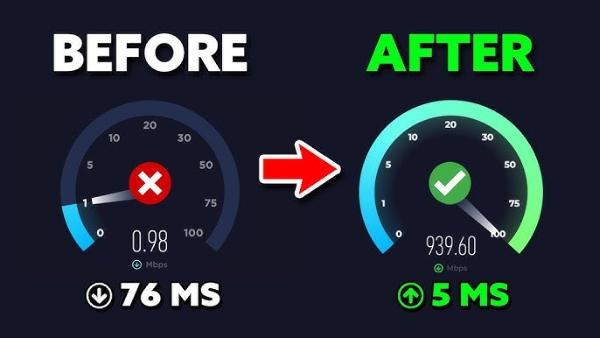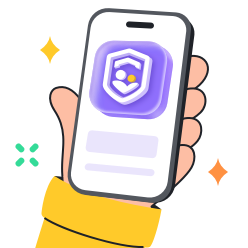There are occasions where, despite having a good connection, you face issues while downloading apps or watching videos. This is frustrating because it interrupts your plans. You may be thinking at the time about how to increase download speed. That is why this blog will going to give you tips to increase the downloading speed. You will also learn the reasons behind slow download speed. And, most importantly, parents will be taught how to protect their children from internet threats. So, keep on reading and know all these things.
Understanding download speed and its importance
What is download speed?
To understand downloading speed, you need to check the online performance of your devices. Because downloading speed refers to how fast your device receives data from the internet. This speed is measured by megabits per second (Mbps). It determines how quickly your device loads data. There are high-speed downloads and low-speed downloads. A higher download speed means:
- Websites load in milliseconds
- Videos are playing without buffering
- Music streams without interruptions
- Apps install or update quickly
- Large files are downloaded in minutes
With a high speed of downloads, everything that is done online is seamless. All the gadgets in your house handle internet activities smoothly. Teenagers and adults have fun or do something on the internet with no lag.
Conversely, a low download speed is frustrating. Overall, web pages are very slow to load. The file transfer is extremely slow, and videos freeze very often. This impacts children and adolescents in their education. They cannot finish online school lessons or video classes. Work-from-home adults cannot properly do their work. And here is the question: how to increase download speed?
Why is download speed important for gaming, streaming, and remote work?
For any online activity, a good download speed is very important. And when it comes to gaming, streaming, and remote work, this becomes more crucial. The reason is that gamers want lag-free online gameplay, and employees have to work with a better download speed without frustration. Here are the reasons:
- Gaming: There are mainly two types of gamers. First, where individuals play only for fun, and second, is professional gamers. They both need a fast download speed. Any lag or poor connection can result in the end of the game. Also, online games often update themselves. Gamers want to play with new updates as soon as possible. If there is poor downloading speed, it can spoil their fun. And professional gamers can see a bad impact on their viewership.
- Streaming: When you watch movies, TV shows, and music on apps or other platforms, a stable downloading speed is very important. If the downloading speed is low, you can not watch freely. There are high definition videos, as well as 4K streaming, and these require a fast downloading speed.
- Remote work: Individuals who work from home are totally dependent on an internet connection. They need fast downloads to share files in real time. Also, in remote jobs, there are client calls, meetings, and discussions. These all things work best with low latency. And if the connection is slow, it affects productivity.
- Online learning: Today’s technology serves a big role in studies. Kids learns so much from the internet, whether it’s for school assignments or additional skills. Here, students need fast downloads for research, video lessons, and assignments.
A low download speed can impact all the people in the house. Parents are not able to work online. Adolescents may become frustrated while online gaming or streaming. Children can experience delays in learning processes. This is the reason a fast download speed is necessary in households.
Shield your children from harmful websites with our effective content filtering.
Common causes of slow download speeds
Slow download speed often results from multiple factors. Knowing the causes helps in applying the right fixes.
Slow Internet connection
When your Wi-Fi signal is weak or fluctuating, downloads will automatically slow. This usually happens when you are far away from the router. Or when there are walls and obstacles between devices.
Network congestion
This happens when there are too many people using the internet simultaneously. The bandwidth is shared among them, reducing the speed of all the connections.
Software interference
One of the least recognized reasons for slow download speeds is software interference. And it occurs when your computer programs/tools clash with your network connection.
Old hardware
The routers, modems, and network cables that have been used for several years might not be compatible with the modern high-speed internet. When your router is still on outdated standards, such as 802.11b/g, then it impacts your download speed.
Background downloads
Sometimes your devices automatically start downloading updates in the background. They can be cloud backups or automatic software updates. These are bulky downloads and affect your online experience.
ISP limitations
Some Internet Service Providers (ISPs) intentionally slow down (throttle) speeds for heavy activities like streaming, gaming, or large downloads to manage bandwidth.
Knowing the problems helps you take steps towards a solution when you encounter a low download speed. However, often solving one issue does not resolve the issue. You have to try multiple hacks for it.
How to test and analyze your current download speed?
Before you try to fix a slow download speed, it is important to know exactly how fast (or slow) your connection really is. This helps you find out the main problem from where it comes from. It can be your provider, your hardware, or your device. Here’s how you can test the current speed of websites and apps:
You can use a number of free, reliable tools to determine your download and upload speed. Popular options include:
- Speedtest by Ookla
- Fast.com
- Google Speed Test
You have to just open one of these sites and press the button Go or Start Test. You can expect to see three important results in a matter of seconds:
- Download Speed (Mbps): How fast data is pulled from the internet to your device.
- Upload Speed (Mbps): How fast data is sent from your device to the internet.
- Ping or Latency (ms): How quickly your device communicates with the server.
Compare results with your Internet plan
Test your Internet connection to determine the speeds that are being promised by your Internet Service Provider (ISP). In the case that your test scores are regularly lower (by a margin of more than 20-30), this is an indicator of a problem.
Run multiple tests on different devices
It is not always your entire internet connection that is the problem. It can be an issue with a particular device. Test your speed on:
- Your laptop or PC (wired and wireless)
- Your smartphone or tablet
- A different browser
When a single device is significantly slower, it may be caused by the software, Wi-Fi card, or background applications of the single device.
Test with and without Wi-Fi
To check whether Wi-Fi is a bottleneck, directly connect your equipment to the router using an Ethernet cable and repeat the test.
- Your Wi-Fi signal or your router location could be the reason if speeds are slow through cable.
- In case the speeds remain slow, then it could be the fault of your ISP or network hardware.
How to increase download speed?



Slow Internet connection
Upgrade your plan if your speed is low. Choose a provider with a reliable network.
Network congestion
Limit simultaneous users. Pause background apps during heavy downloads.
Software interference
Temporarily disable firewalls or antivirus software. Update apps during off-peak hours.
Distance from router
Move devices closer to the router. Avoid thick walls or obstacles blocking signals.
Old hardware
Replace outdated modems and routers. Modern devices handle faster speeds better.
Wi-Fi interference
Change router channels to avoid crowded frequencies. Keep routers away from appliances that cause interference.
Too many devices
Disconnect devices that are not in use. Each device consumes bandwidth.
Background downloads
Schedule large updates or downloads at night. Avoid slowing down other activities.
Browser issues
Clear browser cache regularly. Remove outdated extensions.
Wired connection
Use Ethernet for stable and fast downloads.
Router settings
Enable Quality of Service (QoS) settings. Prioritize devices or apps that need higher speed.
Combining multiple fixes gives the best results.
The dangers families face when downloading too fast
When the downloading speed is fast, users enjoy surfing. They watch movies without pause and download games in seconds. But high speed also brings hidden dangers. When everything downloads quickly, it becomes easy to grab unsafe files before realizing the risk.
Malware and viruses
Many free downloads hide harmful software. These can steal personal data or damage devices. Kids often click links that look harmless. In seconds, malware can enter your home network.
Inappropriate content
Fast connections mean content appears instantly. That includes unsafe material for young eyes. Without filters, children may stumble on adult or violent media.
Cyberbullying and online harassment
Messaging and gaming apps download updates quickly. Some of these spaces allow strangers to send hurtful messages or share offensive content.
Identity theft and scams
Scammers take advantage of quick downloads. Fake websites promise free games, movies, or tools. They trick users into sharing details like names or passwords.
Device overload and data loss
Too many downloads can fill up storage. When space runs out, devices slow down or crash. Important files might get corrupted or lost.
Screen time overload
Fast downloads can make kids spend more hours online. It becomes harder to step away when entertainment is instant.
According to a study, 70% of teens see real-life violence on social media. Parents should monitor their child’s activity to prevent risks like cyberbullying or contact with strangers.
Children are more vulnerable to online threats. Teens may unknowingly access harmful sites. Adults may face malware or scams. Families must balance speed with safety. Fast downloads are safe only when managed carefully.
Always guide children and teach them safe download habits.
Parental control solutions for faster and safer downloads



Ensuring safe and secure downloads
Parental control software like FlashGet Kids monitors downloads. It blocks unsafe or inappropriate files. Parents receive alerts when risks appear. Kids access only safe and appropriate content.
Limiting unwanted or time-consuming downloads
FlashGet Kids can block non-educational downloads. This prevents network slowdowns. Games or large media files cannot consume all the bandwidth. Children focus on learning and safe entertainment.
Balancing screen time with download management
Parental controls allow scheduling heavy downloads. Limit streaming or gaming during study hours. Children learn to manage internet time responsibly. Families enjoy fast downloads safely.
Content filtering and safe download rules
You can set rules that block downloads from unsafe or unknown sources. FlashGet Kids can also let parents filter content by category or by site. In effect, it prevents children from downloading files from harmful or unverified websites.
App & game download control
Game downloads (big ones) can consume a lot of your network bandwidth. FlashGet Kids allows you to control which apps or games the child can download. You can block new installations during busy hours or require parental approval.
Usage reports and download logs
Parents can view logs of downloads, app installs, and browsing history. FlashGet Kids provides usage reports that summarise daily and weekly device activity. You can also see which apps or files consumed the most data. This helps you see which apps your kids scroll the most. This way, you can take corrective actions (like blocking or scheduling those apps).
Parental remote controls
FlashGet Kids allows parents to remotely access their kids’ phones. In addition, suppose the child requires an urgent download for school. You can grant one-time access or temporarily lift a block without giving full permissions.
Conclusion
Homes with high download speeds allow people to work online without interruptions. Whether they’re playing games, streaming, or studying online, they can do their work without lag. However, if you face any issues with your network, you can fix them with quick hacks. You can try limiting devices and clearing the browser cache. Or you can use other hacks also, according to the situation. Additionally, FlashGet Kids keeps downloads safe and productive for you and your kids. And that’s how to increase download speed!

